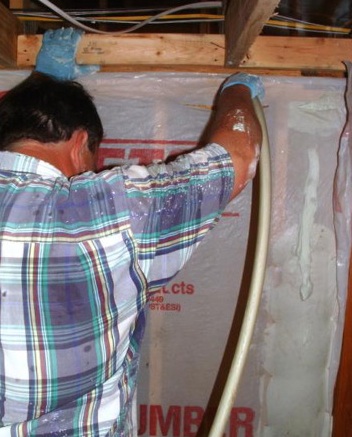Blog Post
Foam-in-Place Insulation

In recent columns, we've looked at cellulose insulation as well as fiberglass and other batt insulation The other option for filling wall and ceiling cavities is foam insulation that is sprayed into the cavity. There are several such materials that are used for this application, all installed by professional insulation contractors.
Polyurethane is by far the most common foam-in-place insulation material used for homes, but there are several quite different formulations. Closed-cell polyurethane has been around for decades, though the ingredients have changed considerably in the past 15 years as ozone-damaging blowing agents were replaced with safer chemicals. The polyurethane is sprayed into the wall or ceiling cavity as a liquid (much like spray paint), and as the components mix they instantly expand, foaming to create the insulation. The material fully cures in a few hours to form a quite hard, high-density (2 pound per cubic foot) material. In a wall cavity, enough material is typically used to expand to several inches thickness, but not so much that the foam bulges beyond the inner face of the framing. Closed-cell polyurethane insulates to between R-5.8 and R-6.8 per inch--a considerably higher insulating value than any other cavity-fill insulation.
Polyurethane insulation is also available in an open-cell formulation. The Canadian company Icynene pioneered this material and is one of the leading producers; Demilec is another. The foam is installed in a similar fashion as closed-cell foam, except that the lower-density foam is usually sprayed so that it fully fills or slightly overfills the cavity--and then the extra is shaved off flush with the inner face of the framing using a specialized tool. The cured foam has a density of about a half-pound per cubic foot and insulates to between R-3.6 and 3.8 per inch. Open-cell polyurethane uses a lot less raw material than closed-cell polyurethane, and it is usually installed to fully fill the cavity, so the overall energy performance is often fairly comparable. It is also available in a more slowly expanding formulation that can be poured into a wall cavity--so it can be used for retrofitting uninsulated finished walls.
Several manufacturers offer biobased formulations of polyurethane insulation in which a portion of one of the polyurethane components is derived from soybean oil, rather than petroleum hydrocarbons. Biobased materials are attractive environmentally because they are renewable, but they also have the unintended negative consequence of raising food prices.
Spray polyurethane insulation, whether closed-cell or open-cell, provides an excellent air seal. If properly installed, it contributes to a very airtight house. In fact, most professionals feel that a separate air/vapor barrier is unneccessary, because the foam will block almost all air and moisture flow on its own.
Besides polyurethane, there are several other foam-in-place insulation materials. One of these, known as Tripolymer foam, is used primarily to fill concrete blocks in commercial construction. It is made from phenol formaldehyde, so it may release some hazardous formaldehyde into the building--but much less than an older formulation of urea-formaldehyde foam insulation (UFFI) that emitted enough formaldehyde to make homeowners sick. UFFI is no longer produced.
SUPPORT INDEPENDENT SUSTAINABILITY REPORTING
BuildingGreen relies on our premium members, not on advertisers. Help make our work possible.
See membership options »Finally, there is a foam-in-place, cementitious insulation, Air Krete, that is made from magnesium oxide (derived from seawater) and ceramic talc mined in upstate New York. Air Krete is totally fireproof, mold-resistant, and does not offgas any volatile chemicals, so it is popular among people suffering from chemical sensitivity. Unfortunately, there are few trained installers, so it may be expensive to use this alternative. (The closest installer to Brattleboro is Eco-Safe Insulation in Northfield, VT, near Montpelier; 802-485-9119.) Other than availability, the biggest problem with Air Krete is that the cured foam is fairly fragile; if exposed to frequent vibration, such as along a busy highway, the foam can begin to disintegrate, reducing its performance. The manufacturer is working to solve this problem.
Whatever the type of cavity insulation used in a house, it is important to remember that it is part of a system. Next week we'll look at rigid boardstock insulation that can be used along with cavity-fill materials to achieve extremely well-insulated walls and roofs.
Published August 25, 2008 Permalink Citation
(2008, August 25). Foam-in-Place Insulation. Retrieved from https://www.buildinggreen.com/blog/foam-place-insulation



Add new comment
To post a comment, you need to register for a BuildingGreen Basic membership (free) or login to your existing profile.